During May’s Special Operations Forces Industry Conference I was taken to an offsite warehouse on the edge of Downtown Tampa’s in order to see the Polaris Defense DAGOR. What I saw was a vehicle larger than anything Polaris had ever offered. You could definitely see that it was a Polaris design, but it was a step up in size from the familiar MRZR. Under development for the past year, the DAGOR was originally created for an undisclosed customer, but it turned out that it fit two other niches quite well.
One of those niches is reflected in the full name of the vehicle: Polaris Defense DAGOR ultra-light combat vehicle. The Maneuver Center of Excellence is working on a requirement for an Ultra-Light Combat Vehicle. Primarily focused on the Global Response Force mission (aka airborne forced entry), the ULCV must be airdroppable and then derigged in two minutes, cannot weigh more than 4500 lbs, offer a 250 mile radius and carry 9 troops with equipment (3200 lbs).
The Army had just released a Sources Sought notice in January of 2014. The DAGOR was one of six vehicles to participate in the Platform Performance Demonstration (ULCV-PPD) from 9-13 June, at Ft Bragg which was used to validate those threshold requirements we just laid out. While the UCLV has been referred to as a “21st century Jeep” it’s actually being asked to do more than the Jeep ever could. For instance, as you can see from these photos taken during the PPD, you can actually fit an Infantry Squad in the DAGOR.
The DAGOR has already had limited public exposure during last month’s Maneuver Conference at Ft Benning as well as Modern Day Marine at Quantico Marine Base but Polaris Defense believes in the DAGOR so much that they started low rate initial production over the Summer.
Intentionally simplistic design of the DAGOR allows for maximum capability on a light-weight platform. It also allows for ease of operation, maintenance and sustainment in support of combat operations. Some of you will note the lack of armor. This is by design. The vehicles already at the Army’s disposal include armored mobility systems. Soldiers in the UCLV will be protected from kinetic threats by their Personal Protective Equipment and will rely on speed and maneuverability to avoid threats. Remember, the UCLV is intended primarily to satisfy a mobility requirement for airborne forces. It is meant to be light, fast and inexpensive.
The DAGOR weighs less than the 4,500 lbs requirement to maximize aircraft transport, operational range and increase vehicle payload. Most of the components that make up the DAGOR include readily available commercial off the shelf (COTS) driveline, controls and components. In fact, the initial customer insisted on such a design so that they could procure spares virtually anywhere. The engine too is a COTS component which burns diesel/JP8. These offer streamlined maintenance and operator training. But that doesn’t mean this is some simple pick-up. The DAGOR introduces a trophy truck-inspired suspension to carry 3,250 lbs of payload or an infantry squad at a higher rate of speed over terrain usually traveled on foot. The current ULCV requirement calls for 10% movement on primary roads, 10% on secondary roads, 75% cross-country and trails, and 5% in urban, rubble environment.
As you can see, it’s pretty straight forward and incorporates an open design in the cargo bed offering adaptability, plenty of room for cargo and ready access for to it. Although I wasn’t able to take any photos of the DAGOR during my brief time with the vehicle in May and I wasn’t able to drive it, I was allowed to sit in the various crew positions. To me, it is very much like a HMMWV except, smaller. In the driver’s seat, you have better visibility than with the HMMWV and the door threshold is very low. It’s very easy to ingress and egress, including the rear cargo area. Everything is closer at hand than with a HMMWV meaning it is a bit more cramped but you don’t have to reach as far for anything either.
While the DAGOR was not designed as an Internally Transportable Vehicle for the V22 Osprey, its narrow width allows rapid loading into rotary wing aircraft (CH/MH47) under ‘other than ideal’ conditions. It can also be sling loaded with the Army’s UH-60 Black Hawk in high altitude, hot weather conditions and naturally, can be rigged for Airborne insertion via fixed wing just like the MRZR. This narrow body also means it is highly maneuverable through areas inaccessible by other vehicles with its capacity.
As you can see from this slide of current and future technologies provided to the SEC last year by Polaris Defense, the DAGOR fits nicely into an expanded family of light vehicles. It also gives you an idea of its size in relation to the other Polaris Defense vehicles. In addition to the US Army’s ULCV requirement, it might well help round out USSOCOM’s Family of Special Operations Vehicles (below). That’s the other “niche” I mentioned at the beginning of the article.
All-in-all, the DAGOR is an interesting platform that can rapidly be procured and adapted to a wide variety of light vehicle duties that have been abandoned along with the entire CUCV and majority of the HMMWV fleets. No matter the branch of service or type of unit, everyone has a requirement for a light utility vehicle. Perhaps that solution is the Polaris Defense DAGOR. Be sure to check the DAGOR out at AUSA next week in Washington, DC.
Tags: Polaris Defense


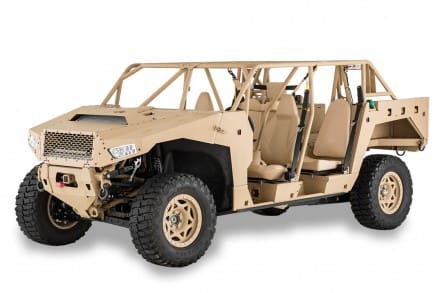
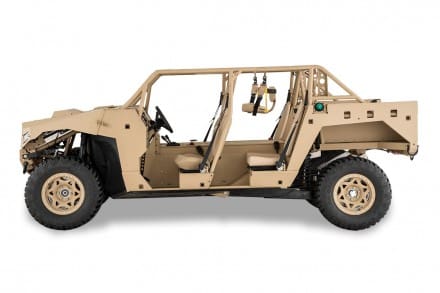
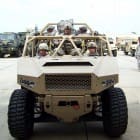
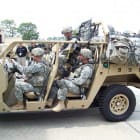
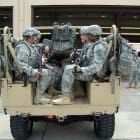
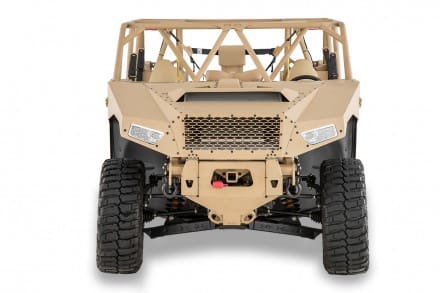
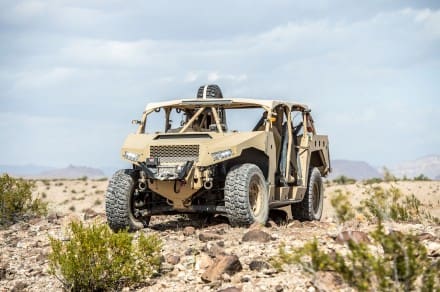
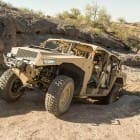
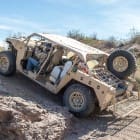

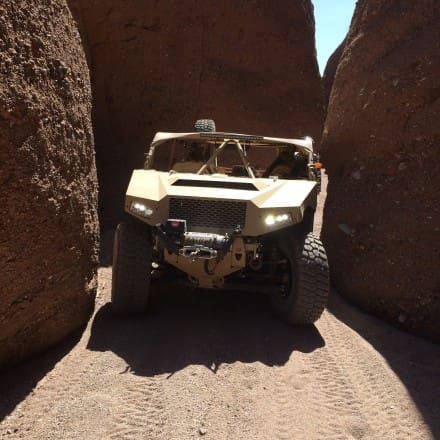
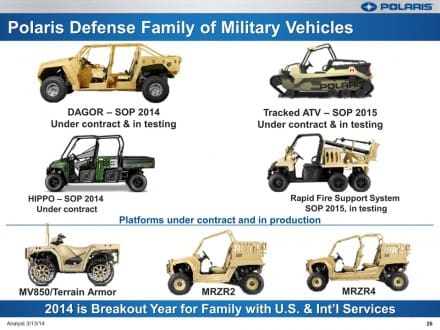

What shape is the hull?
Flat
Even though it is flat, ideally you wouldn’t be driving down an actual road or path, you would be creating your own with this vehicle. Thus mitigating the IED risk. Although a random landmine is still a concern.
If that’s the threat then it ceases to be the vehicle for the job and you use an armored vehicle.
In heavily mined countries like Afghanistan, hitting a randomly scattered mine left over from the Russians is still a threat. But honestly, the odds are still pretty low of hitting that one mine that managed to swim from the known fields.
What engine is it?
Polaris hasn’t disclosed that to me yet.
“That Clark, is what ya’ call yer ‘RV’.” Randy Quaid, “Eddie”, National Lampoon’s Christmas Vacation.
Yes! A wheeled mobility option – a missing, long overdue, major step towards ensuring the relevence and viability of Airborne (and other light infantry) forces.
Now, if we could just go back to the future and also buy a light “tank”/armored gun system to replace the Sheridans that the 82nd lost about 20 years ago. No lengthy development process needed, don’t “buy American votes”, just COTS-purchase a few from the wide selection on the international market.
We had one: M8 Armored Gun System. Contract was awarded, then cancelled in the late 90s due to Clinton era defense spending cuts.
The UCLV is one component of a three vehicle concept that includes mobile protected firepower (MPF) vehicle and a light reconnaissance vehicle (LRV).
Could go low budget for the MPF with a Weisel & 106RR
But, more likely Textron’s Commando Select 90
Can one buy a civilian version of this with all the attachments and colors? If so. I’ll get one ASAP! Just gotta pass it through the war dept and get the 4187 signed off by HOUSEHOLD6!
Amen, not that I could afford one but I can at least dream, haha
Yea, this would make a killing as a civilian version. If they don’t plastic it up too much in the process.
Sorry, CPSC would demand a variety of safety features to keep the local trailer park types “safe” as they illegally operate on the road.
Yes indeed! A civilian version is definitely needed in order for Polaris to complement and supplant the DoD and GOVT business as usual, which means they will order 500 and only pay for 250. I’ll be in line for one of the leftovers. Just hope they make them multi-fuel. (By the way, I want one for me and one for the wife. So here’s to hoping they’re less than a GT500 Shelby Cobra.)
Get a Jeep Cherokee XJ ($1500 or less), take the doors of, rattle can it FDE, throw some 33″ mud tires on it, long arms, 4.5″ lift, m62 or m90 blower on the 4.0L L6 ($1000), and 4.56 gears/lockers. You can leave the top on or chop it. You’ve got a poor man’s version. 😀
http://img.photobucket.com/albums/v31/mrmontez2000/Photo%20Op/Post%20Processed/IMG_1389.jpg
http://img.photobucket.com/albums/v31/mrmontez2000/DesertMetal/DMCOM.jpg
http://youtu.be/32qvC-CE6Q8
DANG! Nice vid.
I was just thinking what the polaris has that a Toyota hilux doesnt!
JOKER! THAT IS OUTSTANDING!
It’s a combat vehicle, what gun can it mount? Is that sling seat in the center facing a pintle for one of the squad’s SAWs?
Is this intended to support its own radios or is this again something provided by the squad’s manpacked equipment?
It’s got a 9 man capacity. Does this mean the basic employment concept is one per rifle squad, and to leave it at the assault position, perhaps with the weapons squad, and assault on foot? I.e., the ULCV is meant to improve operational and strategic mobility, not tactical?
Note that none of these suggestions is meant to be perjorative. We’re talking about a mobility option for airborne forces; I don’t think there’s much middle gorund between this paradigm and a full-up BMD analog.
Yes, you’ve got it. It’s a squad vehicle. Squad organic weapon, organic comms. How it is employed is still up to the doctrine writers, and the units that receive it.
When you talk strategic mobility, airportability through strategic lift means like C-5, C-17, and C-130 is more applicable in terms of the US being able to force project a motorized airborne brigade combat team, as compared to one that is primarily footborne once it hits the ground.
The ‘Combat Vehicle’ nomenclature within the ‘Ultra Light Combat Vehicle’ program is misleading as the vehicle is not armored and doesn’t carry a weapon system larger than 7.62mm. A more apt name would be ‘Ultra Light Mobility Vehicle’.
That’s what MCOE is calling it.
Well I see a great product, how about a street ready version for civilians. Cash on the bank ! I am ready to buy !!!
Come on Polaris… A street version ! Just as is, with signal lights !
I wish Polaris good luck with this, and hope they sell a bunch, but I’d be happy if this ULCV program somehow resulted in the Land Rover Defender returning to the US market.
They’ve stopped manufacturing the Defender,
I understand it will now be made in Brazil.
If the Army selects this, they will find a way to make it useless by adding all srt of crap that is not needed..
Does it sound like a HMMWV?
The up-armored HMMWV was a total accident, created to fulfill an administrative requirement (freedom of movement for the Commander inside the Box without violating the “soft-skinned vehicle” rule).
No mine protection. No protection from a threat beyond 7.62×39. Mostly eyewash, light frag protection from angry peasants and “far misses” of wayward ordinance.
As the rest of the world armed and armored for the fights they could afford to mount (conventional AND asymmetric), we armed and armored for wars concocted by think-tankers who thought, “Well, Viet Nam sucked, let’s not do THAT again.” We validated the concept in Desert Storm and then Somalia happened. The loss of life there was pinned on Les Aspin’s reluctance to put Mech Inf in Somalia, not the reality that the agile Light and SOF elements didn’t have a mobility solution anything like the Bosvark or Buffel, which were proving themselves–on the African continent and beyond–as agile, lethal and protective solutions.
The “FSOV” picture may justify organizing dedicated (I’m gonna be careful with the word “specialized”) Transportation units around mobility options keyed to the threat AND the needs of units whose mission sets require them. Point of reference is the Rangers’ use of Strykers, and SF’s frequent reliance on conventional troops to drive them to the fight.
I think you missed the question, I asked if it sounded like a HMMWV (engine wise), like a Turbo Diesel or was it quieter or louder.
And to follow on, necessity if the mother of all inventions, there was a need and someone came up with an idea to make it happen. This another tool in the toolbox, just hoping the Army doesn’t screw it up too bad..
You are correct, I read that as if you were asking if it “sounded” like the arc the HMMWV took because we had literally THOUSANDS of soft-skinned vehicles in Baghdad–even after Mogadishu showed us what would happen to them–that were hastily armored and pushed to the edge of their performance envelopes…
Astute observation nonetheless. I read the question the same way.
The first steps to a real life warthog from the halo video games. I knew it would happen one day.
One of the light infantry’s primary strengths is it’s light. One of its biggest weaknesses is it’s limited in speed by how fast humans can walk/run under load.
The ULCV is a great concept in that an airborne or heliborne force can land miles away from an objective (maybe even unobserved) and get to the objective very quickly to fight dismounted when it gets there vs. the 3-4 miles per hour of a foot propelled force.
The problem is our casualty aversiveness, the media and whatever political party not in power is going to scream about casualties not understanding that sending in MRAPs and armored vehicles isn’t an option in an airborne/heliborne assault.
My only issue is I wish this vehicle carried 11. That way it could be assigned to transportation companies that get chopped to infantry BN’s as the mission requires. The way it looks now means an Army infantry unit has to take two guys out of the already smaller squad (the Marines 13 man squads vs, the Army’s nine) to operate/secure the vehicle. It also means once a BN gets the vehicles it’s not going to be easy to give the vehicles to another BN should the need arise. How do they get to the other unit? Operator training, maintenance and accountability? http://gruntsandco.com/wheels-airborne-light-infantry/
In the end I don’t think this much needed capability will happen because of money but it’s interesting to watch the doctrinal mistakes already cropping up. BTW, at the Maneuver Conference there were some other vendors competing for the same unfunded program.
RE: squad as crew. There are other options. One model is 5 per rifle platoon; 1 per rifle quad, 1 for the weapons squad, 1 with the PL, PSG, 2 RTOs and excess baggage.
Mounted maneuver to the assault position, cache the the trucks with the weapons squad (w/ PSG?) in the SBP, and conduct operation.
With the Marine rifle squad, you still have the same problem. It’s still required to break down into 4 man teams, you just get 3 fire teams per squad instead of 2. And it doesn’t really matter since this is an Army program for the Army airborne rifle squad. The Marine rifle squad isn’t part of the requirement.
RE: dedicated transporters as crew. If each squad gets one, why is cross-levelling equipment a concern. Train and license the entire squad and treat this as one more piece of squad equipment to maintain or operate.
As for the 9 pax plus 2 crew model, now you have to stretch it another 22 inches (95th percentile shoulder width) for the third seat along each wheelwell. This may take it over the allowed cubage for aircraft transport.
i would even debate assigning 1 squad as the drivers and TC’s for all the vics. and put weapons squad as the gunners. that would leave enough room for a fire team.
Leave the squad who drives the vics as ORP security. write them in to you casulty evac / epw/ ect plan.
Don’t let the vehicles take charge of how you fight.
+1
Fold-down platform on the back for bigger (Marine) squads? Or even better, how about writing the requirement as a Joint Army-USMC thing, before the cement hardens and we are stuck with what we are stuck with?
Consider also that Gen II of this thing, in maybe less than 10 years, may be able to drive autonomously or remotely operated, or slaved to one manned lead vehicle. Do your assault, secure the objective, then digitally command the vehicles to come up from the Dismount Point. They might follow a pre-programmed route (supplemented by AI), or a Soldier on the objective might steer the little robot convoy using a tablet or a heads-up display onhis helmet..or maybe the driving will be done by a guy back at the BN TOC, or in C2 bird, or even a guy on profile in the Rear Detachment back at home station.
If you really want to slow down an acquisition make it a joint one.
Plus, the requirements for a USMC version of a joint ULCV would have it carry 13 Marines and be MV-22 internally transportable, whilst an Army requirement would be that the vehicle have a curb weight of <4500 lbs so as to be sling loadable by a UH-60 under 'hot & high' conditions . You'd probably have more luck riding the unicorn that's grazing beside the pot of gold at the end of the rainbow than finding a vehicle capable of all that.
A 13 man squad mobility vehicle for the Marines would likely be better met by something like a Supacat HMT 600.
“The problem is our casualty aversiveness”
Yes and moms & co and the media bloody shirt mouthpiece cannot seem to grasp that some operations require MRAPs and IOTVs with DAPS, Groin Protectors, and whatnot and some require light vehicles like this and plate carriers. But you cannot have one thing all the time.
You hit the nail on the head.
Finally some sort of sensible alternative to the bloated Humvee beast.
That tracked ATV on the Polaris slide looks pretty wicked too!
Am I reading right, that it’ll fit into a CH-47, but not an Osprey? I knew the Osprey had some cargo limitations, but didn’t know it was smaller than a Chinook!
V-22 cargo space dimensions:
Length: 24 feet, 4 inches (292in/7.41m);
Width: 5 feet, 11 inches (71in/1.80m);
Height: 6 feet (72in/1.83m)
Plus, V-22 is restricted to cargo 60 inches wide by 60 inches high due to the ramp entrance dimensions.
CH-47 cargo space dimensions:
Length: 30 feet, 6 inches (366in/9.29m);
Width: 7 feet, 6 inches (90in/2.28m);
Height: 6 feet, 6 inches (78in/1.98m)
CH-47 ramp entrance allows cargo 90 inches wide by 78 inches high
similar to this from GD ,the weapons mount doesn’t look as stable as it could be https://www.youtube.com/watch?v=VeN0RTo_V7Y
Considerably different. The GDOTS version only has 5 seats, now you need 1/fireteam rather than 1/squad. (And only one fits in the aircraft, so now you need 3 Ospreys to move one Marine squad.) It might be useful for a scout section or mortar carrier, but now you’re ratcheting up logistics requirements with multiple platforms. Let’s not even begin to talk about what happens to the gunner when (not if) one rolls. This vehicle might be useful in the special operations arena or, if it’s front engine mounted, the rear cargo area is re-configured for troop transport.
If your going to try to improve the RSOV, improve the RSOV.
And concerning weapon mounts, there’s a reason TM 9-1010-230-10 forbids firing Mk19s from the M3 pedestals. It looks like GDOTS hasn’t fixed that with the Mk47.